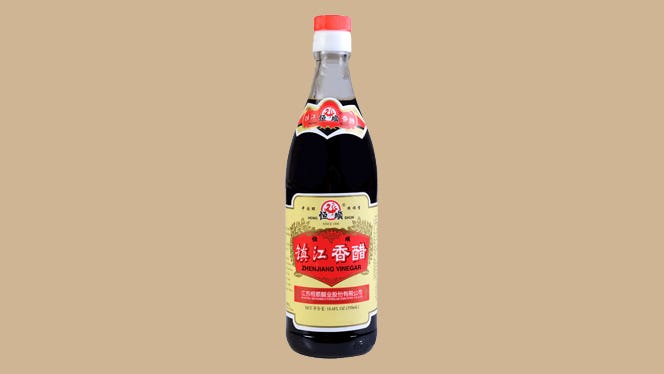
Instant Umami: Why You Should Be Cooking with Black Vinegar
Love Asian flavors? Then a bottle of Chinese black vinegar is a must-have in your pantry. The rice-based vinegar has the power to transform dishes, infusing them with umami-rich flavor—and it’s lower in sodium than soy sauce and tamari, making it a clutch ingredient for health-conscious cooks. Here’s everything you need to know about the aromatic Chinese elixir, from finding a good brand to using it to boost the taste of non-Asian recipes as well.
What Is Black Vinegar?
Black vinegar is an all-natural rice-based vinegar that undergoes an extended aging period (typically six months or more) to give it a rich, dark color and a complex flavor. China, Japan, and Korea all make types of black vinegar, but Chinese black vinegar is the best known and most widely available worldwide. Bottles of Chinese black vinegar made with glutinous rice (aka sticky rice) are sometimes labeled Chinkiang vinegar for Zhenjiang, the Chinese city where it is produced.
Black vinegar is a cornerstone flavor in Chinese cuisine, right up there with soy sauce, ginger, and garlic. Many Chinese restaurants have bottles of black vinegar on the table alongside the soy sauce and chili paste so diners can use it as a seasoning.
Flavor Profile
Malty, smoky, with a mild tang and a hint of sweetness, Chinese black vinegar is what puts the “sour” in hot and sour soup and makes dim sum dumpling sauces so lip-smackingly good. In other Asian dishes, black vinegar helps tame the heat and pungency of ginger and garlic and tempers the intense saltiness of soy sauce. Its long fermentation period means it’s packed with umami, making everything it’s paired with taste even better.
Black Vinegar Substitute
Black vinegar’s flavor is often compared to balsamic vinegar, and the two make good substitutes for each other, in a pinch.
Ways to Use It
In Chinese cuisine, black vinegar provides the piquant base for dipping sauces and dressings. (See below for a simple sauce recipe.) It’s also used to season classic noodle dishes like Dan Dan noodles, as well as slow-cooked stews and braised vegetables.
But you don’t have to limit yourself to Asian cooking with black vinegar. Try using it in place of plain rice vinegar for more full-bodied flavor. Sub it for other vinegars in vinaigrettes and salad dressings. Stir a teaspoon or two into chilis, bean dishes, and soups and stews to brighten and round out hearty flavors.
You can also swap some of the soy sauce in a recipe for black vinegar to cut down on sodium. One tablespoon of black vinegar contains about 100 mg of sodium, compared to 590 mg in reduced-sodium soy sauce.
How to Shop for Black Vinegar
Chinese or Chinkiang black vinegar can be found in dark glass bottles, typically with bright labels, in Asian groceries and the Asian or international section of most well-stocked supermarkets. Check the ingredients list, especially if you’re gluten-sensitive. Some types of black vinegar are made with sorghum, barley, and/or wheat in addition to rice. Not sure which brand to try? Gold Plum Chinkiang Vinegar and Koon Chun Diluted Black Vinegar are both good choices.
Do You Need to Keep Black Vinegar in the Fridge?
Black vinegar can be stored in a cool, dry place such as a pantry—no need to refrigerate it.
Simple Chinese Dipping Sauce
10 minutes | Makes ⅓ cup
Black vinegar and soy sauce play off each other in this classic dipping sauce, which can be whipped up in minutes. Feel free to adjust the amounts according to your taste or add a pinch of ground chile powder or Szechuan peppercorns for heat. Store leftovers in a sealed jar in the fridge for up to a month. It also makes a good salad dressing.
- 2 tablespoons black or Chinkiang vinegar
- 2 teaspoons soy sauce
- 2 teaspoons grated fresh ginger
- 1 teaspoon toasted sesame seeds
Instructions: Combine all ingredients and ¼ cup of water in a small bowl. Let stand for 5 minutes before serving to allow the flavors to develop.
About the Author

About the Author
Mary Margaret Chappell
Join our mailing list
Get free recipes and the latest info on living a happy, healthy plant-based lifestyle.
By providing your email address, you consent to receive newsletter emails from Forks Over Knives. We value your privacy and will keep your email address safe. You may unsubscribe from our emails at any time.
